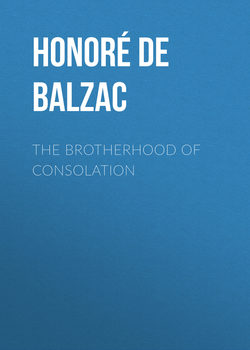The Brotherhood of Consolation

Реклама. ООО «ЛитРес», ИНН: 7719571260.
Оглавление
Honoré de Balzac. The Brotherhood of Consolation
FIRST EPISODE. MADAME DE LA CHANTERIE
I. THE MALADY OF THE AGE
II. OLD HOUSE, OLD PEOPLE, OLD CUSTOMS
III. THE HOUSE OF MONGENOD
IV. FAREWELL TO THE LIFE OF THE WORLD
V. THE INFLUENCE OF BOOKS
VI. THE BUSINESS OF THE HOUSE OF CHANTERIE AND COMPANY
VII. MONSIEUR ALAIN TELLS HIS SECRETS
VIII. WHO SHE WAS – WIFE AND MOTHER
IX. THE LEGAL STATEMENT
X. PRAY FOR THOSE WHO DESPITEFULLY USE YOU AND PERSECUTE YOU
SECOND EPISODE. THE INITIATE
XI. THE POLICE OF THE GOOD GOD
XII. A CASE TO INVESTIGATE
XIII. FURTHER INVESTIGATIONS
XIV. HOW THE POOR AND HELPLESS ARE PREYED UPON
XV. AN EVENING WITH VANDA
XVI. A LESSON IN CHARITY
XVII. HALPERSOHN
XVIII. WHO MONSIEUR BERNARD WAS
XIX. VENGEANCE
ADDENDUM
Отрывок из книги
On a fine evening in the month of September, 1836, a man about thirty years of age was leaning on the parapet of that quay from which a spectator can look up the Seine from the Jardin des Plantes to Notre-Dame, and down, along the vast perspective of the river, to the Louvre. There is not another point of view to compare with it in the capital of ideas. We feel ourselves on the quarter-deck, as it were, of a gigantic vessel. We dream of Paris from the days of the Romans to those of the Franks, from the Normans to the Burgundians, the Middle-Ages, the Valois, Henri IV., Louis XIV., Napoleon, and Louis-Philippe. Vestiges are before us of all those sovereignties, in monuments that recall their memory. The cupola of Sainte-Genevieve towers above the Latin quarter. Behind us rises the noble apsis of the cathedral. The Hotel de Ville tells of revolutions; the Hotel-Dieu, of the miseries of Paris. After gazing at the splendors of the Louvre we can, by taking two steps, look down upon the rags and tatters of that ignoble nest of houses huddling between the quai de la Tournelle and the Hotel-Dieu, – a foul spot, which a modern municipality is endeavoring at the present moment to remove.
In 1836 this marvellous scene presented still another lesson to the eye: between the Parisian leaning on the parapet and the cathedral lay the “Terrain” (such was the ancient name of this barren spot), still strewn with the ruins of the Archiepiscopal Palace. When we contemplate from that quay so many commemorating scenes, when the soul has grasped the past as it does the present of this city of Paris, then indeed Religion seems to have alighted there as if to spread her hands above the sorrows of both banks and extend her arms from the faubourg Saint-Antoine to the faubourg Saint-Marceau. Let us hope that this sublime unity may be completed by the erection of an episcopal palace of the Gothic order; which shall replace the formless buildings now standing between the “Terrain,” the rue d’Arcole, the cathedral, and the quai de la Cite.
.....
“This is it,” she said, entering first.
Was it a miser, was it an artist dying in penury, was it a cynic to whom the world was naught, or some religious soul detached from life, who had occupied this apartment? That triple question might well be asked by one who breathed the odor of that poverty, who saw the greasy spots upon the papers yellow with smoke, the blackened ceilings, the dusty windows with their casement panes, the discolored floor-bricks, the wainscots layered with a sort of sticky glaze. A damp chill came from the chimneys with their mantels of painted stone, surmounted by mirrors in panels of the style of the seventeenth century. The apartment was square, like the house, and looked out upon the inner court, which could not now be seen because of the darkness.
.....